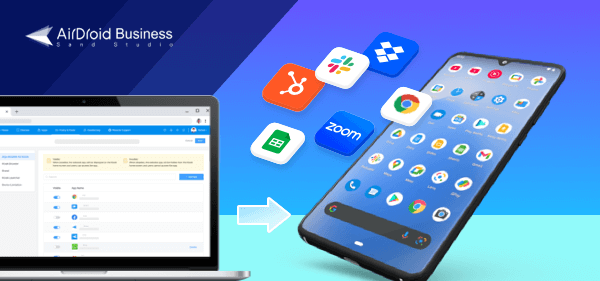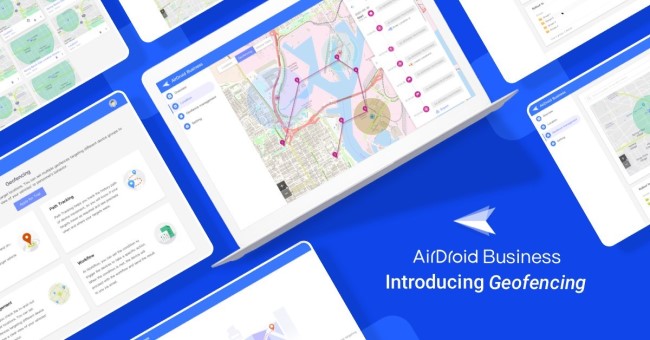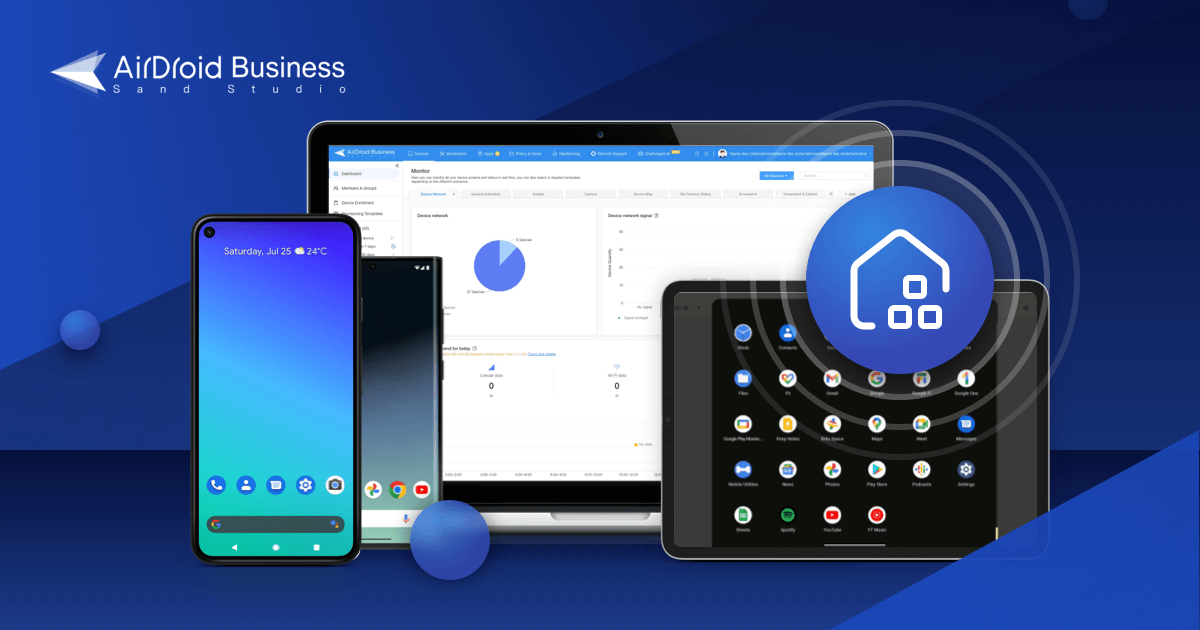MDM Capabilities Overview: What Can MDM Do?
Part 1: What is MDM? What devices are supported?
Mobile Device Management (MDM): It is the controlling and management of mobile devices, including smartphones, tablet devices, rugged devices, kiosks, digital signare, and laptops. Generally, the MDM gets implemented using a third-party product comprising management features for specific vendors of mobile devices.
An MDM solution has two main components:
- Controller: Devices or computers that are being used to manage other devices.
- Controlled End: Android endpoint devices that are being managed remotely. Need a supporting app installed in the devices.
How does MDM work?
Before jumping to MDM capabilities, let's check how it works. An MDM solution depends on the endpoint software, which is known as an MDM agent, and an MDM server that stays in the cloud.
IT administrators construct the policies with the help of an MDM server's management console. After that, the server pushes the policies over the air to the MDM agent on the device. Now, the agent's role is to apply the policies to the device by interacting using the APIs (such as Android Enterprise) built directly into the device's operating system.
Similarly, an IT administrator can utilize the MDM software for devices to be managed with the MDM server.

Part 2: Core MDM software capabilities
- Feature 1 : Enrollment & Deployment
- Feature 2 : Mobile App Management (MAM)
- Feature 3 : Device Compliance Policy/Policy
- Feature 4 : Kiosk Mode - Lockdown Device
- Feature 5 : Remote access & control
- Feature 6 : Geofencing
- Feature 7 : User management
- Feature 8 : Others - based on the MDM software you use
Feature 1: Enrollment & Deployment
Four different ways for enrollment involves:
- Regular Enrollment
The Regular Enrollment method involves installing the controlled end app on the employees' devices. It needs no permission from the Device Owner for your device. - Device Owner Enrollment
In Device Owner Enrollment, you allow your device to get permission from the device owner. Two methods involved in it are:- a. 6 times tap
- b. Enrollment via USB
- Android Enterprise Enrollment
This enrollment uses the Managed Google Play Store feature with devices. It allows the pre-installation or direct addition of apps from the Google Play Store. - Zero-Touch Enrollment
Zero-Touch enrollment involves the deployment of bulk company-owned devices without any manual setup.
Feature 2: Mobile App Management (MAM)
Mobile App Management falls under one of the Mobile Device Management capabilities that involves appropriately providing the internally developed or commercially available mobile apps utilized in businesses.
It offers various controls at different levels, which helps in effective system administration. Some important functions include the facility of the app allow list, block list, installation, uninstallation, and more.
Furthermore, MDM's Mobile App Management capability offers Google Play Store management and configures the app with auto-update rules. The users also get the facility to test or schedule the release of the company-owned apps. This feature helps in effectively clearing the cache and monitoring better.

Feature 3: Device Compliance Policy
Another Mobile Device Management capability involves the device compliance policy. It helps to set up the rules and then manage how the devices should be utilized. In the policy feature, various configurations are available, including Password, WiFi, and APN. Every rule that is listed will be applied to the employee devices.
Information regarding system updations, system setting restrictions, and more exists. You will also get to effectively manage the device policy's USB, language, and volume settings. Besides, there is also mandatory storage encryption that will be helpful in protecting crucial data.
MDM policy detailed features
- Password Configuration
- System Update
- System Setting Restrictions
- Wifi Configuration
- APN Configuration
- USB Settings
- Language Settings
- Volume Setting
- Mandatory Storage Encryption
- Others
Feature 4: Kiosk Mode - Lockdown Device
In Kiosk Mode, Android devices get locked for a specific application or website. When a device has this mode, it gets restricted from accessing any other use of the setting. Therefore, the device turns into a particular device for a specific purpose. With MDM Kiosk mode, you can get the single or multi-app mode.
Moreover, with such device management capabilities, there is the facility for a customizable screen layout that will be displayed on your device. Besides, you can also limit the device functions, including Wireless network, volume, cellular data, hotspots, Bluetooth, and more. There is always a secure code for Kiosk mode.
MDM kiosk mode detailed features
- Single-app kiosk mode
- Multi-app kiosk mode
- Kiosk Browser
- Kiosk Launcher
- Device Limitation
Feature 5: Remote access & control
MDM also has a feature of remote access and control. It allows the administrators to access the full catalog device by presenting it anywhere in the world. The device could be anything like your smartphone, tablet, or laptop. The administrators have overall control over managing confidential company data and ensuring proper updates.
When it is about controlling the data from a remote location, it involves various facilities for the devices. Some of the examples involve a remote camera, remote wipe, remote reboot, remote screen lock, and more. Besides, remote controlling also deals with one or bulk file transfer.
Feature 6: Geofencing
Another excellent MDM software capability includes geofencing. It is a security feature that allows enterprises to define and enforce location-specific security policies on the devices. It is applicable to all the mobile devices of your organization. It effectively manages the devices and ensures the security of corporate data.
With the help of this MDM capability, the companies can effectively track the location and paths of the employee devices. It also offers the inclusion of giving alert notifications. Besides, auto remote operations are also available for the proper management with the MDM solutions.

Feature 7: User management
User management is one of the remarkable MDM capabilities that keeps control over all the activities happening with the devices. They can access it easily if there is any compromised device, people try to misuse the device, and more. These kinds of circumstances stay under the control of the IT team with mobile data security.
Furthermore, the users do not need to go for millions of logins for every task, and they can use a single dashboard of the MDM software. There is also complete control over the assigned roles and permissions. Also, there will be a practical facility for assignments to the device groups.
Feature 8: Others - based on the MDM software you use
Last but not least, MDM software capabilities are according to the option you choose for your enterprise. Every solution has its unique features along with the basic ones. If we take an example, it includes the notification for the force read. There can also be a function to use the devices with the black screen mode.
Many MDM software offers an automated workflow to smooth the overall business operations for every candidate. Another excellent option that many software offers is reporting. It means there will be an easy approach to reporting anything for a feasible work environment.

MDM Buyer's Guide
Enroll Android devices in bulk, manage apps, and remotely troubleshoot anytime.





Leave a Reply.